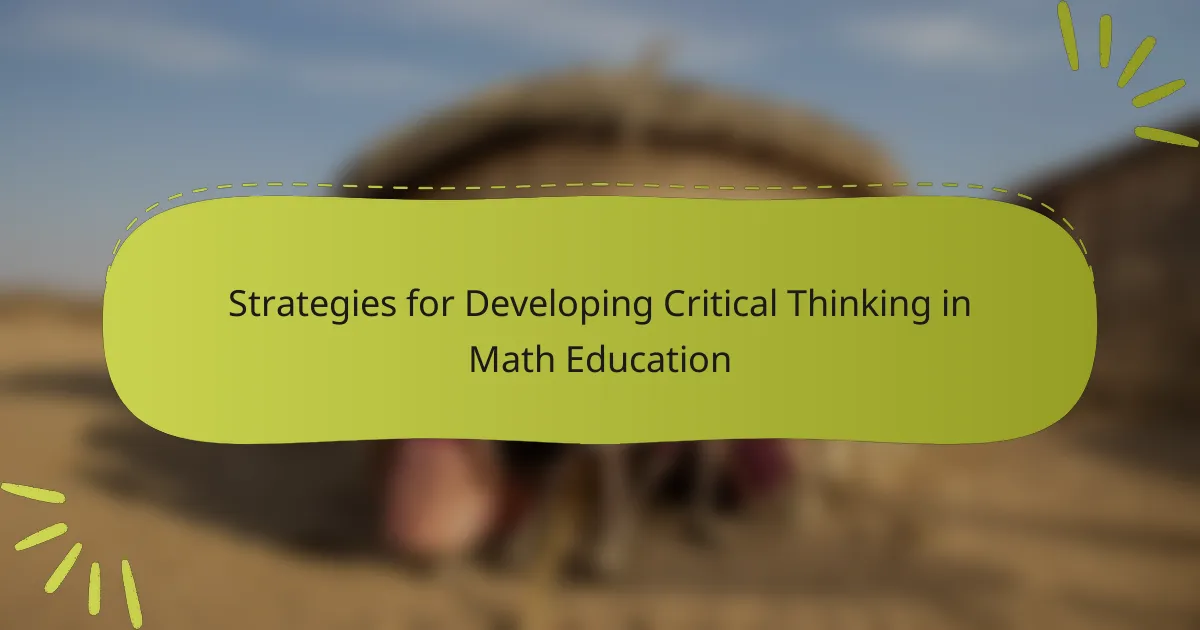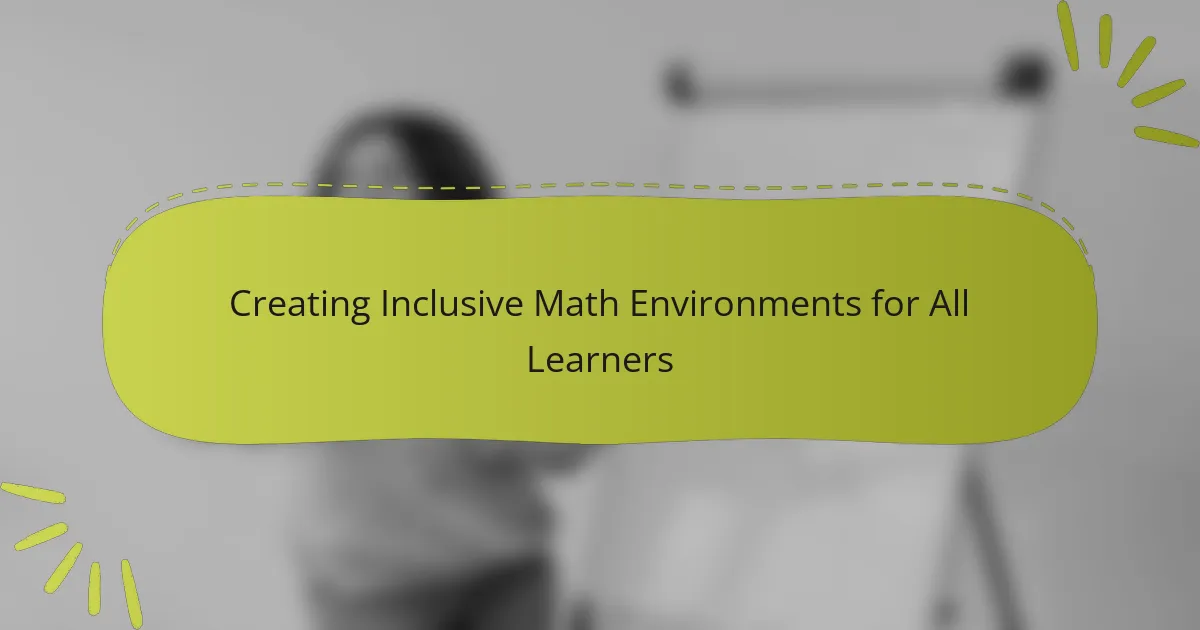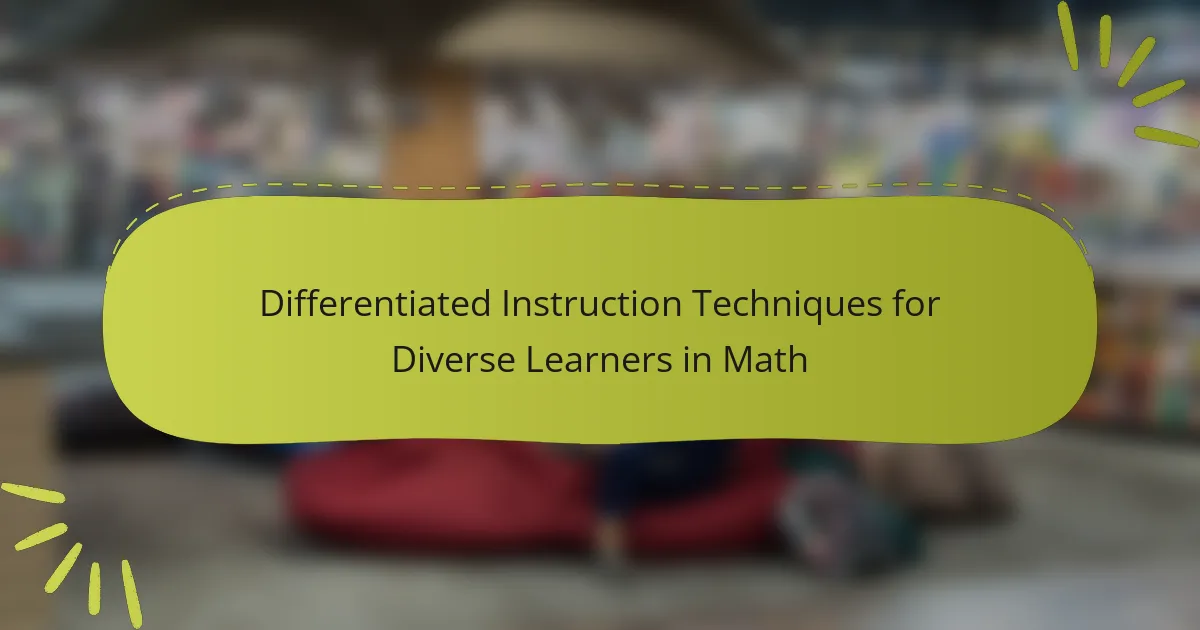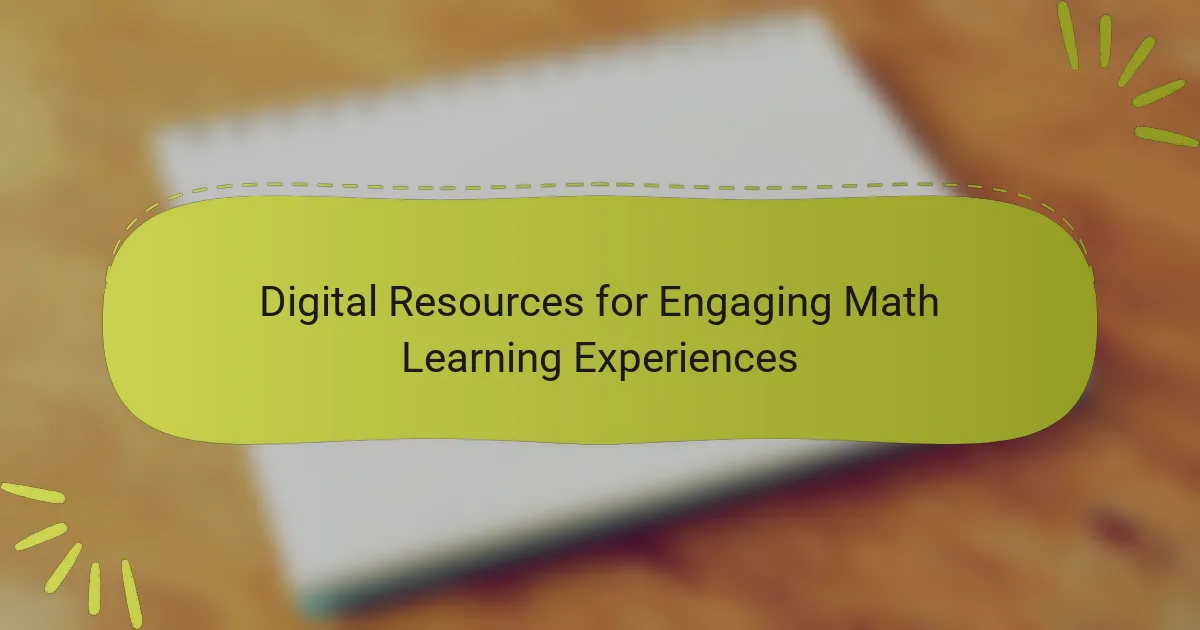Effective math instruction relies on essential curriculum components that include clear learning objectives, instructional strategies, assessment methods, and educational materials. Clear learning objectives specify the knowledge and skills students are expected to acquire. Instructional strategies encompass a range of teaching methods designed to accommodate diverse learning styles. Assessment methods are utilized to measure student understanding and progress, while materials such as textbooks, manipulatives, and technology facilitate the learning process. Research from the National Council of Teachers of Mathematics supports the notion that structured curricula significantly enhance students’ problem-solving abilities and conceptual comprehension.
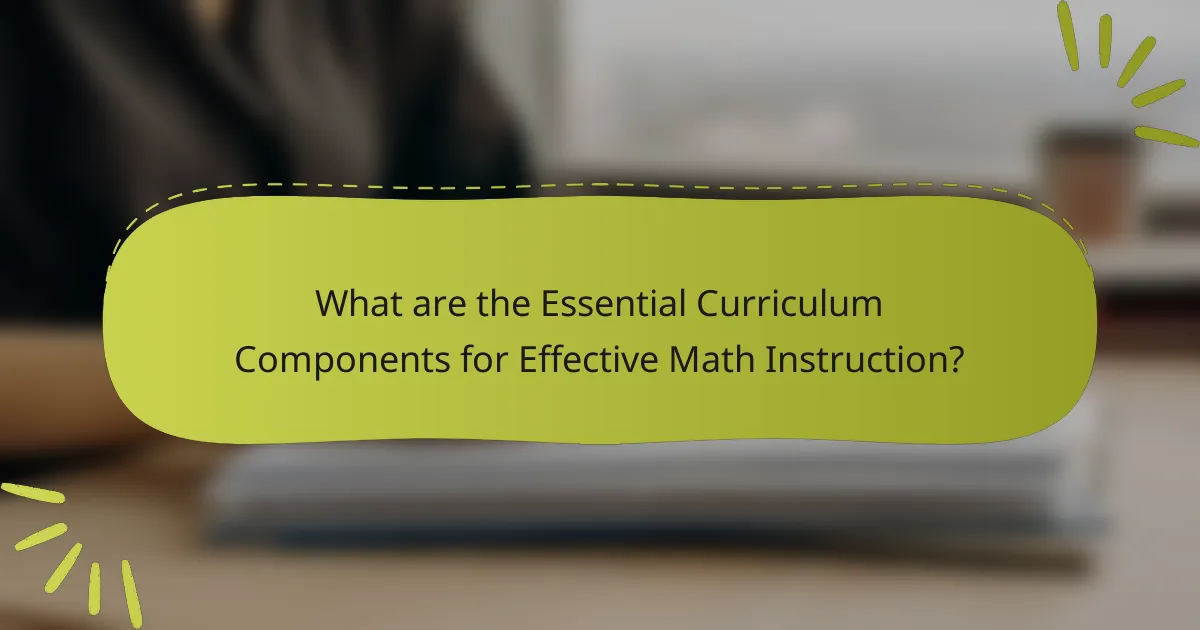
What are the Essential Curriculum Components for Effective Math Instruction?
The essential curriculum components for effective math instruction include clear learning objectives, instructional strategies, assessment methods, and materials. Clear learning objectives define what students should know and be able to do. Instructional strategies involve various teaching methods tailored to diverse learning styles. Assessment methods evaluate student understanding and progress. Materials include textbooks, manipulatives, and technology that support learning. Research indicates that effective math instruction leads to improved student outcomes. According to the National Council of Teachers of Mathematics, structured curricula enhance students’ problem-solving skills and conceptual understanding.
Why is an effective curriculum crucial for math instruction?
An effective curriculum is crucial for math instruction because it provides a structured framework for teaching and learning. This framework ensures that concepts are introduced in a logical sequence. It aligns learning objectives with assessment methods. Research shows that students achieve higher math proficiency when taught through a well-designed curriculum. For instance, a study by the National Mathematics Advisory Panel found that coherent curricula lead to better student outcomes. Additionally, effective curricula incorporate various teaching strategies to cater to diverse learning styles. They also include formative assessments to monitor student progress. Thus, an effective curriculum is foundational for successful math instruction.
What are the key characteristics of an effective math curriculum?
An effective math curriculum is coherent, rigorous, and aligned with educational standards. It emphasizes problem-solving and critical thinking skills. The curriculum should be relevant to students’ lives and interests. It incorporates various teaching strategies to cater to diverse learning styles. Continuous assessment is essential to monitor student progress and inform instruction. Professional development for educators enhances the implementation of the curriculum. Research indicates that aligned curricula improve student achievement by providing clear learning objectives and consistent content progression.
How does curriculum alignment impact student learning in math?
Curriculum alignment significantly enhances student learning in math by ensuring that educational standards, assessments, and instructional practices are coherent and interconnected. When curriculum components are aligned, students receive consistent messages about learning objectives. This consistency helps students to build on prior knowledge effectively. Research indicates that aligned curricula can lead to improved student performance. For instance, a study by the National Center for Education Statistics found that students in aligned programs scored higher on standardized math tests. Furthermore, alignment facilitates targeted instruction, allowing teachers to address specific learning gaps. Overall, effective curriculum alignment is crucial for maximizing student achievement in math.
What foundational elements should be included in a math curriculum?
A math curriculum should include number sense, operations, algebra, geometry, measurement, and data analysis. Number sense involves understanding numbers and their relationships. Operations cover addition, subtraction, multiplication, and division. Algebra introduces variables and expressions, essential for problem-solving. Geometry focuses on shapes, their properties, and spatial reasoning. Measurement teaches the concepts of length, area, volume, and time. Data analysis involves collecting, organizing, and interpreting data. These elements are foundational for developing mathematical skills and critical thinking. Research shows that a well-rounded curriculum enhances student engagement and achievement in mathematics.
What role do learning objectives play in math instruction?
Learning objectives serve as a roadmap for math instruction. They clarify what students are expected to learn and achieve. These objectives guide teachers in planning lessons and assessments. They help in aligning instructional strategies with desired outcomes. Learning objectives also enable students to understand the goals of their learning. Research shows that clear objectives improve student engagement and performance. For example, a study by Hattie (2009) indicates that well-defined learning goals can increase student achievement by up to 30%. Thus, learning objectives are essential for effective math instruction.
How can instructional materials enhance the math learning experience?
Instructional materials enhance the math learning experience by providing concrete examples and visual aids. They help students understand abstract concepts through tangible representations. High-quality materials, such as manipulatives, textbooks, and digital resources, support diverse learning styles. Research indicates that students using varied instructional materials show improved problem-solving skills. A study by the National Council of Teachers of Mathematics found that interactive materials increase engagement and retention. Additionally, instructional materials facilitate collaborative learning, allowing students to work together on math problems. This collaboration fosters deeper understanding and critical thinking. Overall, effective instructional materials are essential for creating a rich math learning environment.
How does assessment fit into the math curriculum?
Assessment is an integral part of the math curriculum. It helps educators measure student understanding and progress. Regular assessments inform instruction and identify areas needing improvement. Formative assessments guide daily teaching decisions. Summative assessments evaluate overall student learning at the end of units. Research shows that effective assessment practices enhance student achievement. According to the National Council of Teachers of Mathematics, assessments should align with learning goals. This alignment ensures that assessments accurately reflect student capabilities.
What types of assessments are most effective in measuring math proficiency?
Formative assessments are most effective in measuring math proficiency. These assessments occur during the learning process. They provide immediate feedback to both students and teachers. Examples include quizzes, exit tickets, and classroom discussions. Formative assessments help identify areas needing improvement. Summative assessments, like standardized tests, also measure proficiency but at a later stage. Research shows formative assessments improve student learning outcomes significantly. A study by Black and Wiliam (1998) found that formative assessments can raise student achievement by up to 30%.
How can formative assessments inform ongoing instruction in math?
Formative assessments can guide ongoing instruction in math by providing real-time feedback on student understanding. These assessments identify specific areas where students struggle. Teachers can then adjust their instructional strategies accordingly. For example, if many students miss a particular concept, the teacher can revisit that topic. This targeted approach enhances learning and retention. Research shows that formative assessments lead to improved student performance. According to a study by Black and Wiliam (1998), effective formative assessment can increase student achievement by up to 30%. Thus, formative assessments play a crucial role in shaping instructional practices in math classrooms.
How can technology be integrated into math instruction?
Technology can be integrated into math instruction through various methods. Interactive software can provide students with engaging practice opportunities. Tools like graphing calculators can facilitate complex problem-solving. Online platforms offer access to a wealth of resources and instructional videos. Virtual manipulatives allow students to visualize mathematical concepts. Learning management systems enable personalized learning experiences. Data analytics can track student progress and inform instruction. Research indicates that technology enhances student engagement and understanding in mathematics.
What tools and resources are available for enhancing math learning through technology?
Digital tools and resources for enhancing math learning include online platforms, apps, and software. Platforms like Khan Academy offer interactive lessons and exercises. Apps such as Photomath help students solve problems using their smartphone cameras. Software like GeoGebra provides dynamic geometry and algebra tools. Virtual manipulatives, such as those found on the National Library of Virtual Manipulatives, facilitate hands-on learning. Learning management systems, like Google Classroom, support organization and communication. These resources have been shown to improve student engagement and understanding in mathematics. Research indicates that technology integration can lead to better academic performance in math.
How does technology support differentiated instruction in math?
Technology supports differentiated instruction in math by providing personalized learning experiences. It enables students to work at their own pace, addressing individual learning needs. Adaptive learning software adjusts the difficulty of math problems based on student performance. This allows for tailored practice that meets each student’s skill level. Online resources offer diverse instructional materials, catering to various learning styles. For instance, visual learners benefit from interactive simulations, while auditory learners can access instructional videos. Additionally, technology facilitates immediate feedback, helping students understand mistakes in real-time. Research shows that differentiated instruction using technology can lead to improved student engagement and achievement in math.
What strategies can educators use to implement these curriculum components effectively?
Educators can implement curriculum components effectively by utilizing differentiated instruction. This approach tailors teaching methods to accommodate varying student needs. For instance, teachers can use flexible grouping strategies to facilitate collaborative learning. Incorporating formative assessments helps educators gauge student understanding in real-time. This allows for timely adjustments to instruction. Additionally, integrating technology can enhance engagement and provide interactive learning experiences. Research shows that technology use in math instruction can improve student outcomes. Furthermore, aligning lessons with real-world applications makes learning relevant and meaningful. Studies indicate that context-based learning enhances student motivation and retention. These strategies collectively foster a supportive learning environment conducive to effective math instruction.
How can collaboration among educators improve math instruction outcomes?
Collaboration among educators can significantly enhance math instruction outcomes. When teachers work together, they share best practices and resources. This collective approach leads to more effective teaching strategies. Research shows that collaborative teaching can improve student engagement and understanding. For instance, a study by Vescio et al. (2008) found that collaborative professional development positively impacts student achievement in math. Additionally, collaboration allows educators to address diverse learning needs more effectively. By pooling their expertise, teachers can create a more inclusive learning environment. This ultimately results in improved math performance among students.
What best practices should be followed for effective math curriculum delivery?
Effective math curriculum delivery requires clear objectives, engaging content, and continuous assessment. Establishing clear learning objectives helps guide instruction and student expectations. Engaging content should incorporate real-world applications to enhance relevance and interest. Continuous assessment allows for monitoring student progress and adjusting instruction as needed. Differentiated instruction caters to diverse learning styles and abilities. Regular professional development for educators ensures they stay informed about best practices. Collaboration among educators fosters sharing of strategies and resources. Utilizing technology can enhance learning experiences and provide interactive opportunities. These practices lead to improved student understanding and performance in mathematics.
What common challenges do educators face in math instruction?
Educators face several common challenges in math instruction. One major challenge is diverse student skill levels. Students often have varying backgrounds in math, which complicates lesson planning. Another challenge is student engagement. Many students find math difficult and lose interest quickly. Additionally, educators struggle with curriculum alignment. Standards may not match classroom materials, creating gaps in learning. Time constraints also pose a significant issue. Teachers often have limited time to cover extensive math content. Furthermore, access to resources can be uneven. Some schools lack adequate materials and technology for effective instruction. Lastly, professional development opportunities may be insufficient. Educators need ongoing training to enhance their teaching strategies. These challenges collectively impact the effectiveness of math instruction in classrooms.
How can teachers overcome barriers to effective math instruction?
Teachers can overcome barriers to effective math instruction by employing differentiated instruction strategies. This approach tailors learning experiences to meet diverse student needs. Teachers can assess students’ prior knowledge to identify gaps. They can then provide targeted interventions to address those gaps. Utilizing manipulatives and visual aids enhances understanding for visual learners. Incorporating technology, such as math software, engages students and provides interactive learning. Collaborative learning opportunities foster peer support and communication skills. Regular feedback helps students understand their progress and areas for improvement. Research indicates that differentiated instruction leads to higher student achievement in math (Tomlinson, 2001).
What resources are available to support teachers in enhancing math curricula?
Teachers can access various resources to enhance math curricula. These resources include online platforms, professional development workshops, and curriculum guides. Websites like Khan Academy and IXL offer interactive lessons and practice problems. Teacher resource centers provide materials tailored to state standards. Professional organizations, such as the National Council of Teachers of Mathematics, offer workshops and conferences. Additionally, educational publishers provide textbooks and supplementary materials. Research shows that teachers using these resources improve student engagement and understanding in math.
What are the best practices for ongoing improvement in math instruction?
Best practices for ongoing improvement in math instruction include regular assessment, professional development, and collaborative teaching. Regular assessments help identify student needs and inform instructional adjustments. Professional development enables teachers to learn new strategies and stay updated on best practices. Collaborative teaching fosters a supportive environment where educators can share insights and resources. Research indicates that schools implementing these practices see improved student outcomes. For example, a study by Hattie (2012) found that feedback and teacher collaboration significantly enhance student achievement in mathematics.
How can continuous professional development enhance math teaching skills?
Continuous professional development enhances math teaching skills by providing educators with updated knowledge and effective teaching strategies. It allows teachers to stay informed about the latest research in mathematics education. This ongoing training helps teachers implement best practices in their classrooms. Additionally, professional development fosters collaboration among educators. Such collaboration leads to sharing of resources and teaching techniques. Research shows that teachers who engage in continuous learning improve student outcomes. A study by the National Mathematics Advisory Panel indicated that effective professional development significantly impacts student achievement in math. Therefore, continuous professional development is crucial for enhancing math teaching skills.
What role does feedback play in improving math instruction effectiveness?
Feedback is crucial for improving math instruction effectiveness. It provides learners with specific information about their performance. This information helps students identify their strengths and weaknesses. Effective feedback can guide students toward better problem-solving strategies. Research shows that timely feedback enhances student understanding. According to Hattie and Timperley’s meta-analysis, feedback significantly influences learning outcomes. It can increase student achievement by providing clarity on misconceptions. Moreover, feedback fosters a growth mindset, encouraging persistence in learning. Overall, feedback is an essential component of effective math instruction.
What practical tips can enhance the implementation of effective math instruction?
Utilizing diverse teaching strategies enhances effective math instruction. Incorporate visual aids, manipulatives, and technology to cater to different learning styles. Regular formative assessments help track student progress and adapt instruction accordingly. Encourage collaborative learning through group activities to promote peer interaction. Provide real-world context to math concepts to increase relevance and engagement. Differentiate instruction to meet individual student needs and abilities. Establish a growth mindset by celebrating effort and persistence in learning. Continuous professional development for teachers ensures they stay updated with best practices in math instruction.
The main entity of this article is the “Essential Curriculum Components for Effective Math Instruction.” The article outlines the critical elements necessary for successful math teaching, including clear learning objectives, diverse instructional strategies, effective assessment methods, and appropriate materials. It emphasizes the importance of curriculum alignment, foundational math elements, and the role of technology in enhancing learning experiences. Additionally, it addresses common challenges educators face and offers practical strategies for overcoming these barriers to improve student engagement and achievement in mathematics.
